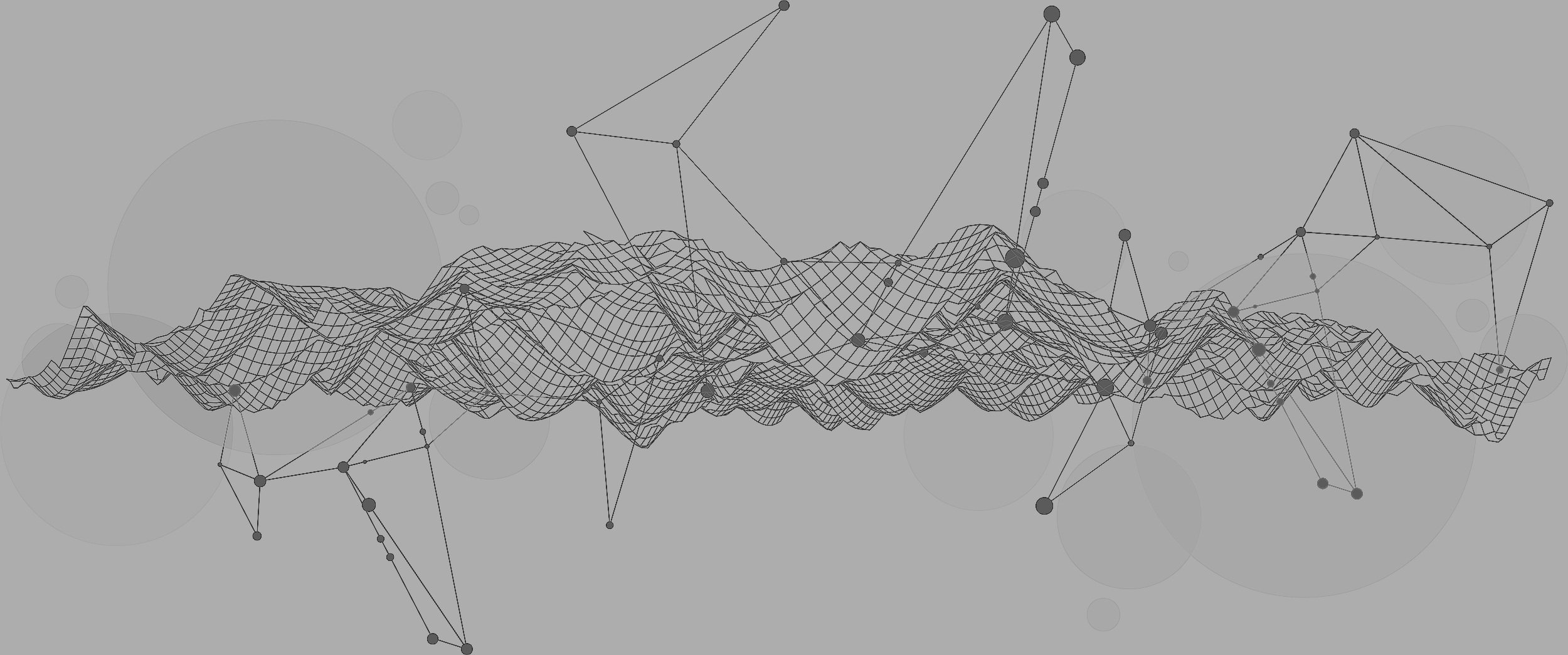Data has shape and shape has meaning. Ingenuity applies topology sciences to understand business data
Ingenuity
Ingenuity at Wingenium is a sophisticated Topology-driven class of services that focuses on extracting and segmenting complex, high-dimensional, non-linear correlations to uncover hidden patterns and causal relationships in data. The essence of Ingenuity lies in its ability to handle and analyze a vast array of unstructured and unlabeled data as well as tabular or time-series data. This includes diverse data types such as stock market trends, cryptocurrency fluctuations, textual comments, user behaviors, image analysis, sensor data from the Internet of Things (IoT), predictive maintenance data, cyber security threats, and customer activities.
Topological Data Analysis (TDA)
The core technology behind Ingenuity is Topological Data Analysis, especially, Persistent Homology and Keppler Mapper algorithms. TDA has broad applications in IoT, cyber security, text, and activity analysis. It projects high-dimensional data in a topological map to a lower dimension keeping all the features intact, making it more comprehensible and analyzable for subject matter experts. Its ability to handle complex, high-dimensional data and identify subtle patterns and relationships makes it an ideal choice for tackling challenging problems in fields like healthcare, environmental monitoring, cybersecurity, and more.
Key features of Ingenuity
Explainable Intelligence: Ingenuity's technology ensures that the data-driven insights are understandable and transparent.
Explainability interface: The Ingenuity platform does not require users to have extensive knowledge of machine learning, making it accessible to a broader audience.
Proprietary Machine Learning Algorithms: These are specifically designed for analyzing complex data sets.
Web-Based Analytical Platform: It offers an interactive platform for data analysis.
Flexible Deployment Models: Ingenuity supports both Software-as-a-Service (SaaS) and on-premises deployment models.
Big Data Support: The framework is designed to handle large datasets, to the tune of 3000 features or petabytes of data.
Advanced Data Segmentation: State-of-the-art unsupervised data segmentation is a key feature.
Deep Clusters and Models: These models are used to identify complex patterns in the data.
Success Stories
Image Analysis for Chip Manufacturing: Ingenuity has been applied in scenarios like analyzing NAND chip production photos from electron microscopes, assisting in image segmentation and anomaly detection, and overlaying image data with additional metadata.
Sensor Data Analysis in Aerospace: In the context of aircraft engines, Ingenuity assists in analyzing data from numerous sensors, contributing to predictive maintenance and cost-saving measures.
Major Benefits for our clients
Reduced Manual Review: Particularly in image analysis, it significantly decreases the amount of manual data/image review and labeling.
Faster Issue Resolution: It enables faster review and improvement of processes in manufacturing.
Data Science Team Performance Improvement: Ingenuity helps improve the performance of data science teams in complemeting their analytics.
Pattern Identification: It enables domain experts to identify previously unnoticed patterns in complex datasets.
Ingenuity leverages advanced data analysis techniques to provide meaningful insights and solutions across various sectors, enhancing operational efficiency and decision-making processes.
Ingenuity applies Topology Sciences to real-life use cases
Healthcare and Life Sciences
Medical Imaging: Ingenuity uses topology modeling to analyze medical images such as MRIs, CT scans, and X-rays to identify patterns and features that can aid in disease diagnosis and treatment planning.
Genomics: TDA is also applied to genomic data to study the topological structure of genetic information, enabling researchers to better understand gene expression, regulation, and interactions.
Drug Discovery: TDA helps in identifying potential drug targets and optimize lead compounds by analyzing large datasets of chemical and biological information.
Environmental Monitoring and Climate Science
Climate Modeling: TDA applies to atmospheric and oceanic data to improve climate models, predict weather patterns, and understand the impact of climate change on ecosystems.
Environmental Monitoring: Analyze sensor data from environmental monitoring stations, providing insights into pollution levels, temperature fluctuations, and other environmental factors
IoT and Smart Cities
Sensor Networks: Process and analyze data from large-scale sensor networks, helping to monitor and manage infrastructure, traffic flow, energy consumption, and public safety in smart cities.
Building Management Systems: Optimize building performance by analyzing data from sensors and meters, identifying opportunities for energy efficiency improvements and cost savings.
Cybersecurity
Network Intrusion Detection: Detect anomalies and vulnerabilities in network traffic, enhancing cybersecurity measures and protecting against threats.
Malware Analysis: Identification of malicious soaware and understanding its behavior, enabling the development of more effective anti-virus solutions.
Retail and Marketing
Customer Segmentation: Grouping and classifying customers based on their purchasing habits, demographics, and other characteristics, allowing for targeted marketing campaigns and personalized customer experiences.
Supply Chain Optimization: Analyzing supply chain data to identify bottlenecks, reduce costs, and improve overall efficiency.
Social Media and Web Analytics
Community Detection: Reveal hidden communities within social media platforms, enabling businesses to tailor their marketing strategies to specific audience segments.
Sentiment Analysis: Analyze sentiment in online reviews, comments, and posts, providing valuable insights into customer opinions and preferences.
Traffic Management and Transportation
Traffic Flow Prediction: Traffic data to forecast traffic patterns, reducing congestion and improving travel times.
Route Optimization: Optimal routes for vehicles, minimizing fuel consumption and lowering emissions.
Manufacturing and Industrial Automation
Predictive Maintenance: Analyze sensor data from industrial equipment, enabling predictive maintenance and reducing downtime.
Quality Control: Identification of defects and anomalies in manufactured products, ensuring high-quality output and reducing waste.
Agriculture and Food Production
Yield Prediction: Agricultural data, predicting crop yields and optimizing farming practices.
Pest and Disease Management: Identification of patterns in pest and disease outbreaks, enabling targeted treatments and reducing the use of harmful chemicals.
Energy and Utilities
Power Grid Management: Optimize power distribution and transmission, reducing energy losses and improving grid resilience.
Energy Consumption Analysis: Helping households and businesses understand their energy usage patterns, enabling them to make informed decisions about energy conservation and efficiency.
Topological Data Engineering and Analysis Business Use-Cases
Healthcare and Life Sciences
Use-Case: Disease Biomarker Discovery
TDA analyzes biological data, such as gene expression profiles, to identify hidden patterns and biomarkers associated with diseases. It then captures topological features that linear methods might miss.
Use-Case: Drug Discover
TDA analyzes molecular and genomic data to discover new drug candidates and understand complex relationships between molecules and their effects on diseases.
Finance
Use-Case: Anomaly Detection in Financial Transactions.
TDA detects unusual paWerns in financial transactions by modeling transaction networks as topological graphs. It identifies suspicious activities that traditional methods, such as associative rule mining might overlook.
Use-Case: Portfolio Optimization
TDA helps in optimizing investment portfolios by identifying non-linear correlations between financial instruments and assessing portfolio risk.
Manufacturing
Use-Case: Quality Control and Process Optimization
TDA helps in analyzing high-dimensional sensor data from manufacturing processes. It identifies complex relationships and paWerns in multi-dimensional IoT data obtained from device sensors to optimize producyion and maintain product quality.
Retail and E-commerce
Use-Case: Customer Behavior Analysis
TDA analyzes customer purchase histories and behaviors to identify clusters of similar customers. This enables personalized recommendations and targeted marketing.
Energy and Utilities
Use-Case: Predictive Maintenance of Equipment
TDA analyzes sensor data from industrial equipment to detect early signs of failure. It identifies topological changes in sensor networks, indicating potential issues.
Social Sciences
Use-Case: Community Detection in Social Networks
TDA is applied to social network data to uncover hidden communities or groups. It captures the topological structure of connections.
Internet of Things (IoT)
Use-Case: Sensor Data Fusion
In IoT applications, TDA fuses data from diverse sensors (e.g., temperature, humidity, and motion) to identify complex correlations and make informed decisions.
Use-Case: Anomaly Detection
TDA detects anomalies in IoT sensor data by capturing complex relationships, making it suitable for predictive maintenance and fault detection.
Transportation and Logistics
Use-Case: Route Optimization and Traffic Analysis
TDA analyzes traffic flow data and road networks. It helps in optimizing routes, predicting traffic congestion, and improving logistics.
Natural Language Processing (NLP)
Use-Case: Text Data Analysis
In NLP, TDA analyzes document similarity, topic modeling, and sentiment analysis by modeling text data as topological structures, capturing semantic relationships.
Oil and Gas
Use-Case: Reservoir Characterization
TDA analyzes seismic data to characterize underground reservoirs. It captures topological features to improve reservoir modeling and oil extraction strategies.
In all these sectors, TDA provides an advantage by preserving the intrinsic geometry and topology of data. It helps uncover hidden structures, identify anomalies, and make data-driven decisions that may not be apparent through traditional statistical methods. TDA's ability to capture complex relationships and patterns makes it a valuable tool for diverse applications.

Would you like more information?
If you want to more information about this subject please get in touch with our Topology expert, who would be pleased to hear from you.
Invoke Ingenuity Data Topology Specialist
Ingenuity Framework is designed and maintained by our Data Topology team who are backed by our R&D on TDA sciences.








